Houstonia caerulea
A beautiful tiny plant appearing in the woods in late spring
Houstonia caerulea azure bluet
Azure bluet or quaker ladies is a low-growing perennial herb with pale blue, delicate florets less than 1 inch across, forming dainty patches in lawns, meadows, and grassy woodland edges. Each flower is solitary, with a yellow center, borne on slender 3–6 inch stems that rise in a group from a single basal rosette. Blooming from April to July, the flowers attract small bees, butterflies, and other gentle pollinators. The medium green leaves are arranged in opposite pairs along the stem, while spoon-shaped basal leaves form a persistent rosette at the base.
Bluets are native to eastern Canada and the eastern United States, ranging from Maine to Wisconsin, south to Florida and Louisiana, with scattered populations in Oklahoma. They thrive in moist, acidic soils in shady or partly sunny areas, and adapt to a variety of soil types thanks to their fibrous roots and slender rhizomes.
Houstonia caerulea is found in habitats such as lawns, meadows, forest edges, lake and river shores, rocky cliffs, and even disturbed sites. In spite of its very small size and delicate flowers, it is an exceptionally hardy plant, capable of surviving even under adverse conditions.
The Cherokee used an infusion of this plant to treat bedwetting, reflecting its gentle role in traditional medicine. While early European settlers likely admired its delicate blooms, specific cultural uses are less clearly documented.
Habitat & Range
Common in meadows, lawns, open woods and wood edges. Prefers partial sun to light shade and moist, acidic soils.
Present throughout the state.
Range: Native to eastern Canada and the eastern United States, ranging from Maine to Wisconsin, south to Florida and Louisiana, with scattered populations in Oklahoma.
| EMP: | FACU |
|---|---|
| NCNE: | FACU |
Phenology
Flowers April through June, or later.
Fruiting starts shortly after flowering, with bloom and fruit period overlapping.
Fruits May throught July, may extend into August.
Characteristics
Flowers solitary on long pedicels, nodding or erect; corolla light blue with yellow center, 4 wide-spreading petals; less than 1″ across
Leaves stem leaves sessile, opposite (2 per node), smooth, widely spaced on the stem, reduced; basal leaves in rossette, spoon-shaped, slightly hairy, persistent, avg. ½″ long
Stems smooth, mostly unbranched, thin, slightly angled
Fruit small, green, compressed, rounded dehiscent capsule; each fruit contains multiple tiny seeds with pebbly or textured surfaces
Height 3-6 inches
Plant Codes
S-rank: S5 (Secure)
G-rank: G5 (Secure)
Ecology
Nectar and pollen are both available to a variety of small pollinators. The flowers attract Little Carpenter bees (Ceratina spp.), Green Metallic bees and other Halictid bees, bee flies (Bombyliidae), and small butterflies, including the Meadow Fritillary (Boloria bellona) as a frequent visitor. The plant also serves as a larval host for the Spotted Thyris moth (Thyris maculata).
Due to its small stature and delicate foliage, Houstonia caerulea is generally unpalatable to deer and rabbits, and is considered resistant to browsing.
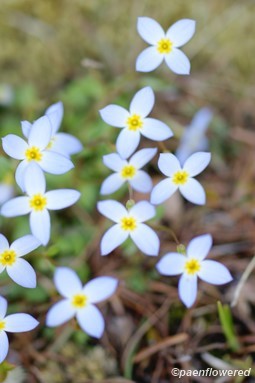
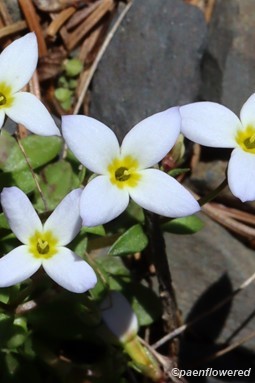
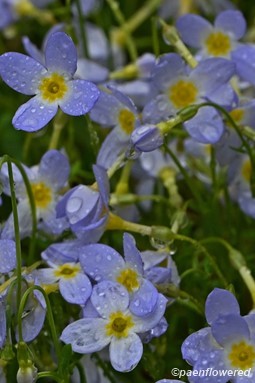
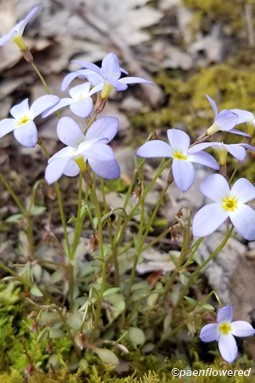
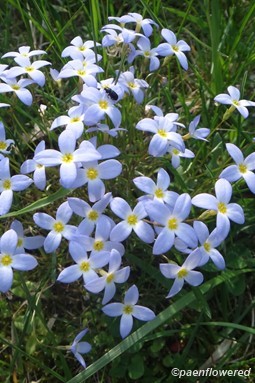
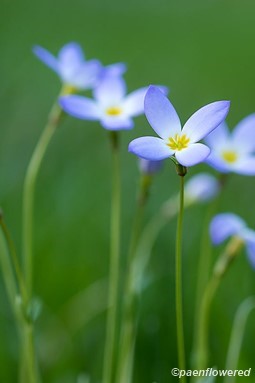
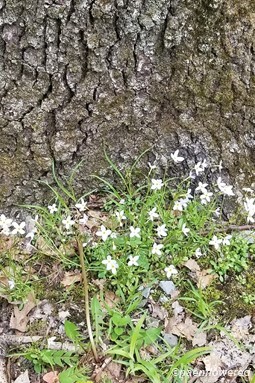
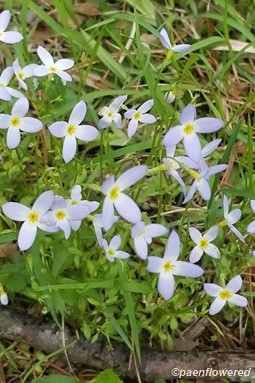


Comments
Have you spotted this plant in your area? We'd love to hear about your experience! Share your comments or questions about the plant below. Comments are moderated before posting.